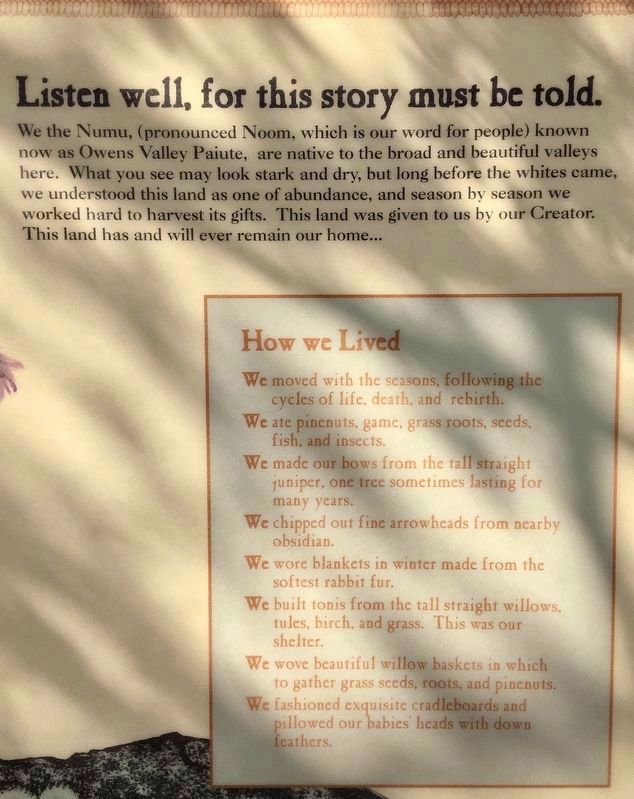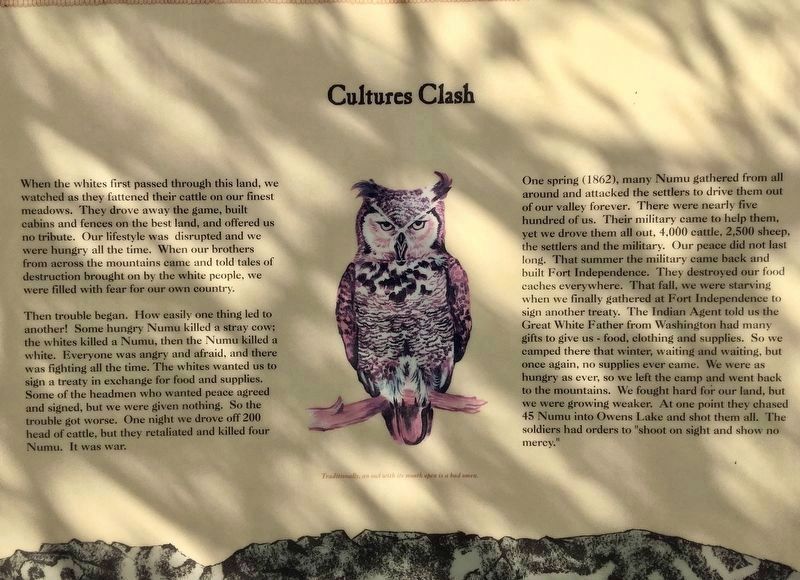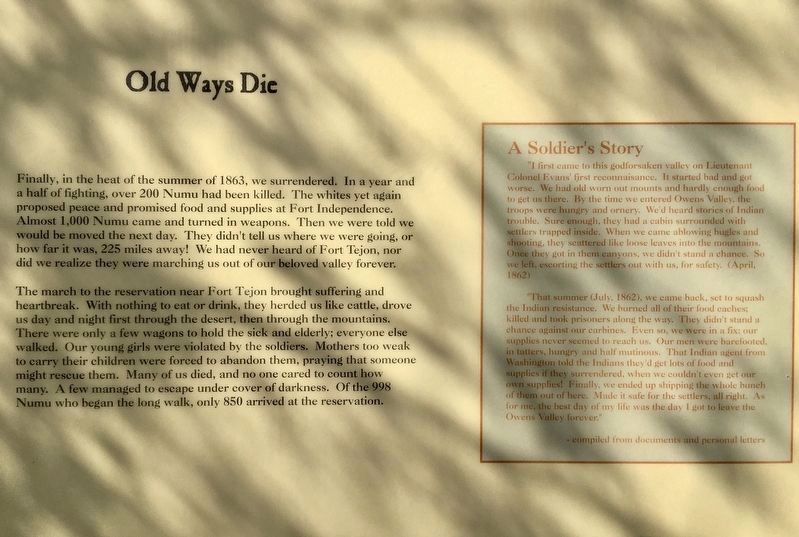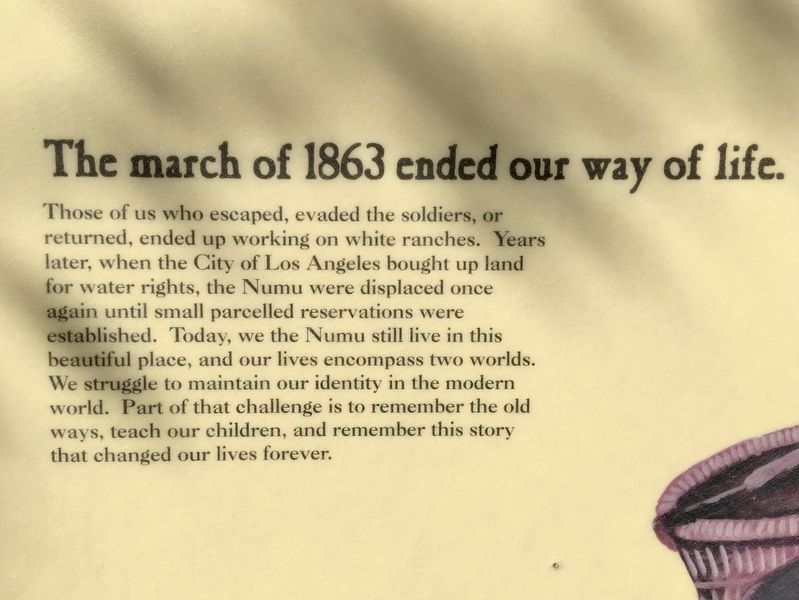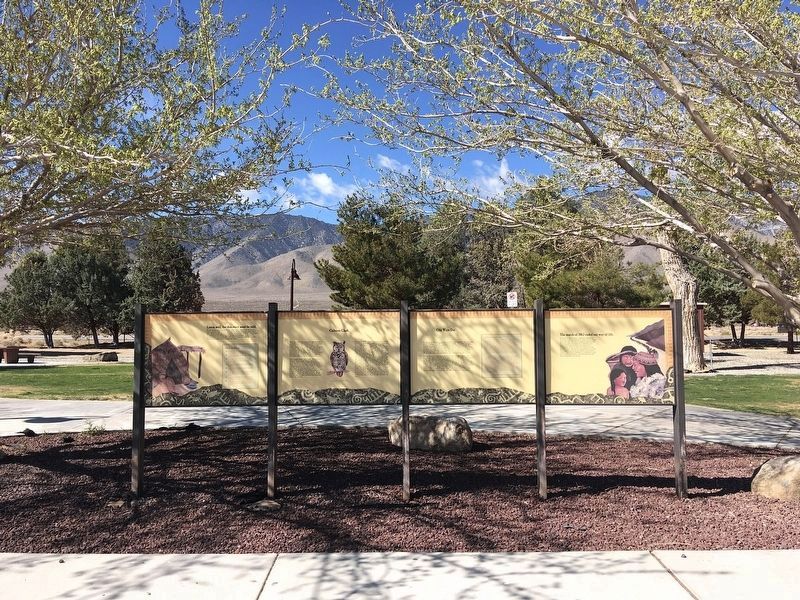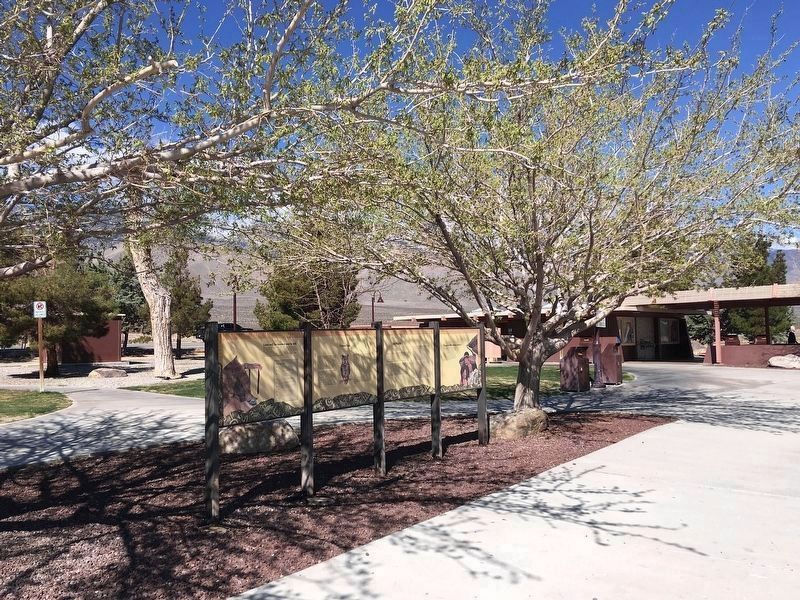Coso Junction in Inyo County, California — The American West (Pacific Coastal)
Listen Well, For This Story Must Be Told
Native Americans in the Owens Valley
We the Numu, (pronounced Noom, which is our word for people) known now as Owens Valley Paiute, are native to the broad and beautiful valleys here. What you see may look stark and dry, but long before the whites came, we understood this land as one of abundance, and season by season we worked hard to harvest its gifts. This land was given to us by our Creator. This land has and will ever remain our home.
How we Lived
We moved with the seasons, following the cycles of life, death, and rebirth. We ate pinenuts, game, grass roots, seeds, fish, and insects. We made our bows from the tall straight juniper, one tree sometimes lasting for many years. We chipped out fine arrowheads from nearby obsidian. We wore blankets in winter made from the softest rabbit fur, We built tonis from the tall straight willows, tules, birch, and grass. This was our shelter. We wove beautiful willow baskets in which to gather grass seeds, roots, and pinenuts. We fashioned exquisite cradleboards and pillowed our babies' heads with down feathers.
Cultures Clash
When the whites first passed through this land, we watched as they fattened their cattle on our finest meadows. They drove away the game, built cabins and fences on the best land, and offered us no tribute. Our lifestyle was disrupted and we were hungry all the time. When our brothers from across the mountains came and told tales of destruction brought on by the white people, we were filled with fear for our own country.
Then trouble began. How easily one thing led to another! Some hungry Numu killed a stray cow; the whites killed a Numu, then the Numu killed a white. Everyone was angry and afraid, and there was fighting all the time. The whites wanted us to sign a treaty in exchange for food and supplies. Some of the headmen who wanted peace agreed and signed, but we were given nothing. So the trouble got worse. One night we drove off 200 head of cattle, but they retaliated and killed four Numu. It was war.
One spring (1862), many Numu gathered from all around and attacked the settlers to drive them out of our valley forever. There were nearly five hundred of us. Their military came to help them, yet we drove them all out, 4,000 cattle, 2,500 sheep, the settlers and the military. Our peace did not last long. That summer the military came back and built Fort Independence. They destroyed our food caches everywhere. That fall, we were starving when we finally gathered at Fort Independence to sign another treaty. The Indian Agent told us the Great White Father from Washington had many gifts to give us - food, clothing and supplies. So we camped there that winter, waiting and waiting, but once again, no supplies ever came. We were as hungry as ever, so we left the camp and went back to the mountains. We fought hard for our land, but we were growing weaker. At one point they chased 45 Numu into Owens Lake and shot them all. The soldiers had orders to "shoot on sight and show no mercy."
Old Ways Die
Finally, in the heat of the summer of 1863, we surrendered. In a year and a half of fighting, over 200 Numu had been killed. The whites yet again proposed peace and promised food and supplies at Fort Independence. Almost 1,000 Numu came and turned in weapons. Then we were told we would be moved the next day. They didn't tell us where we were going, or how far it was, 225 miles away! We had never heard of Fort Tejon, nor did we realize they were marching us out of our beloved valley forever.
The march to the reservation near Fort Tejon brought suffering and heartbreak. With nothing to eat or drink, they herded us like cattle, drove us day and night first through the desert, then through the mountains. There were only a few wagons to hold the sick and elderly; everyone else walked. Our young girls were violated by the soldiers. Mothers too weak to carry their children were forced to abandon them, praying that someone might rescue them. Many of us died, and no one cared to count how many. A few managed to escape under cover of darkness. Of the 998 Numu who began the long walk, only 850 arrived at the reservation.
A Soldier's Story:
“I first came to this godforsaken valley on Lieutenant Colonel Evans’ first reconnaissance. It started bad and got worse. We had old worn-out mounts and hardly enough food to get us there. By the time we entered Owens Valley, the troops were hungry and ornery. We’d heard stories of Indian trouble. Sure enough, they had a cabin surrounded with settlers trapped inside. When we came blowing bugles and shooting, they scattered like loose leaves into the mountains. Once they got in them canyons, we didn’t stand a chance. So we left, escorting the settlers out with us, for safety.” (April, 1862)
"That summer (July, 1862), we came back, set to squash the Indian resistance. We burned all of their food caches; killed and took prisoners along the way. They didn't stand a chance against our carbines. Even so, we were in a fix; our supplies never seemed to reach us. Our men were barefooted, in tatters, hungry and half mutinous. That Indian agent from Washington told the Indians they'd get lots of food and supplies if they surrendered, when we couldn't even get our own supplies! Finally, we ended up shipping the whole bunch of them out of here. Made it safe for the settlers, all right. As for me, the best day of my life was the day I got to leave the Owens Valley forever."
- compiled from documents and personal letters.
The march of 1863 ended our way of life.
Those of us who escaped, evaded the soldiers, or returned, ended up working on white ranches. Years later, when the City of Los Angeles bought up land for water rights, the Numu were displaced once again until small parcelled reservations were established. Today, we the Numu still live in this beautiful place, and our lives encompass two worlds. We struggle to maintain our identity in the modern world. Part of that challenge is to remember the old ways, teach our children, and remember this story that changed our lives forever.
Topics and series. This historical marker is listed in these topic lists: Native Americans • Wars, US Indian. In addition, it is included in the Trail of Tears series list. A significant historical year for this entry is 1863.
Location. 36° 2.67′ N, 117° 56.768′ W. Marker is in Coso Junction, California, in Inyo County. Marker is on US-395, on the right when traveling north. Located in the highway rest area. Touch for map. Marker is in this post office area: Olancha CA 93549, United States of America. Touch for directions.
Other nearby markers. At least 3 other markers are within 8 miles of this marker, measured as the crow flies. Coso Hot Springs (within shouting distance of this marker); Fossil Falls (approx. 5.4 miles away); Native Americans in the Owens Valley (approx. 7.3 miles away).
Credits. This page was last revised on July 31, 2022. It was originally submitted on April 6, 2022, by Craig Baker of Sylmar, California. This page has been viewed 400 times since then and 61 times this year. Photos: 1, 2, 3, 4, 5, 6. submitted on April 6, 2022, by Craig Baker of Sylmar, California.
